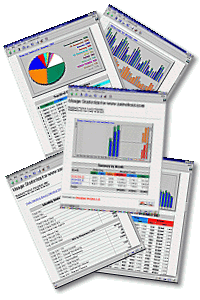There are several tools available to analyse and monitor visits to a website or blog in real-time. The common method for reliable tracking consist in inserting a simple piece of javascript code on every webpage and saving a first party cookie on the visitors computer. The cookie allows to distinguish between returning visitors and first time visitors. The sum of returning and first time visitors are called unique visitors.
IP + User Agent tracking typically reports higher numbers than cookie-based tracking because of dynamically assigned IP addresses and spider and robot visits. 3rd party cookies are set by a source other than the website being visited and are often blocked by browsers and security software, whereas 1st party cookies are considered as harmless by spyware protection software.
The most used free tracking and statistics packages are StatCounter, SiteMeter and Google Analytics. A comparison of StatCounter versus Google Analytics has been published by Andy Atkinson on his blog “Pain in the Tech“.

Google Analytics
I prefer Google Analytics, which is based on Urchin, and I use it for different websites since 2006. Google Analytics uses 1st partie cookies, counts a visit even if the page is pulled from a user’s or server’s cache, but it registers only one visit if a user comes to a site twice within thirty minutes without closing their browser. The Google Analytics reports include a dashboard with different site usage overviews and detailed informations about visitors, content, traffic sources and goals. All the data are anonymous and the privacy of the visitors is guaranteed.
Google provides a help page, an official blog and a conversion university for Google Analytics. An unofficial Google Analytics Blog is provided by ROI Revolution. A forum about Website Analytics – Tracking and Logging is available at WebmasterWorld.com. A solid tutorial “8 stupid things webmasters do to mess up their analytics” has been edited by Linda Bustos on Marketing Pilgrim. SiteScan offers a Google Analytics Diagnostic tool designed to provide you with a complete audit of your Google Analytics setup.
Nicolas Lierman is the author of the Google Analytics Reporting Suite developed in Adobe AIR. He published on his website AboutNico.be 5 tips for using Google Analytics.

Webalizer
A famous log file analysis programm for web servers is Webalizer. It produces highly detailed, easily configurable usage reports in HTML format, for viewing with a standard web browser. Written in C by Bradford L. Barrett who started the development in 1997, the program is open source and was designed for running on Linux systems. Version 2.20-01 was released on july 12th, 2008. “What is your webserver doing today ?” is the motto of the webalizer website.


